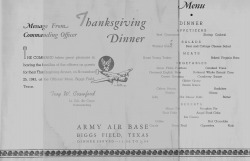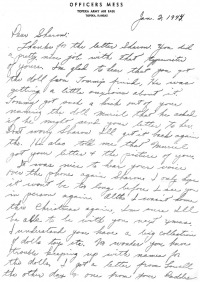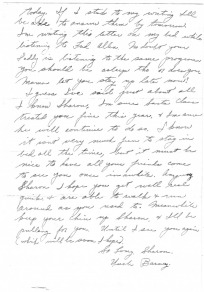Bernard Breiter and the B-24 "Lil' Audrey"
Bomber Training
The B-26

Barney's first bomber training was on the B-26 bomber from March '43 - May '43, based at MacDill, FL.
This included trips to Melbourne,Orlando and Miami, FL. In June - July '43 he was flying the B-26 based at Myrtle Beach, SC.
"When this bomber first entered service it quickly became known as the "Widow-Maker" due to the high numbers of crashes relative to other types. This was not caused by a design flaw but a design philosophy. When Martin created the design for the 1939 medium bomber competition for the U.S. Army it pulled out all the stops. Chosing a wing design that optimized cruise efficiency that unfortunately sacrificed low-speed handling. When pilots transitioned to the type training was insufficient in regards to this characteristic and thus less experienced pilots suffered. Additional training rectified this problem and by VE-day the B-26 had achieved the lowest loss rate of any U.S. Bomber in the ETO. The Marauder was deployed to the South Pacific the day after Pearl Harbor and was used extensively throughout the theatre." (picture and quote courtesy warbirdsresearchgroup.org)
This included trips to Melbourne,Orlando and Miami, FL. In June - July '43 he was flying the B-26 based at Myrtle Beach, SC.
"When this bomber first entered service it quickly became known as the "Widow-Maker" due to the high numbers of crashes relative to other types. This was not caused by a design flaw but a design philosophy. When Martin created the design for the 1939 medium bomber competition for the U.S. Army it pulled out all the stops. Chosing a wing design that optimized cruise efficiency that unfortunately sacrificed low-speed handling. When pilots transitioned to the type training was insufficient in regards to this characteristic and thus less experienced pilots suffered. Additional training rectified this problem and by VE-day the B-26 had achieved the lowest loss rate of any U.S. Bomber in the ETO. The Marauder was deployed to the South Pacific the day after Pearl Harbor and was used extensively throughout the theatre." (picture and quote courtesy warbirdsresearchgroup.org)
First Training in B-24s at Biggs Field, El Paso, TX August, 1943 - December, 1943
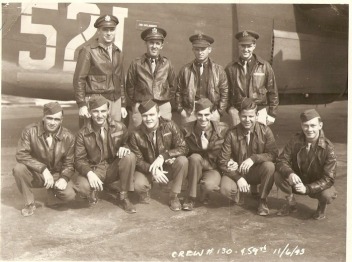
This crew would train together on the B-24D,E,G,H and J. Most of them would ship to Hickam Field, HI before deploying to the Pacific. The B-24 by most accounts was a very difficult plane to master. Crews already overseas were transitioning from the B-17 to the B-24. Most didn't prefer the B-24.
"At the same time it was a complicated and advanced machine, leading to prolonged pilot training programs and on occasion to severe attrition. Not only was it demanding to fly, even to a pilot fully qualified on the type, but it was eventually cleared to operate at such high weights that take-offs became marginal even with full power on all engines. Flight stability was also marginal, and escape from a stricken machine was extremely difficult once the pilot or pilots had let go of the controls. Moreover, though more modern and in most ways more efficient than the B-17, the overloaded late-model B-24s were hardly any improvement over their more primitive partners, and several commanders, including 'Jimmy' Doolittle, famed commanding general of the 8th Air Force, preferred the old B-17." From www.b24.net
Above Standing L-R: Stephen J Coffey (Bombardier), Thomas G. Page (Navigator), Bernard J. Breiter (Co-Pilot), Francis Pouls (Pilot)
Crouching L-R: Unidentified (Tail Gunner), Alex C. Shinsky (Radio/Wastegunner), William B. Gannon (Wastegunner), Unidentified (Engineer), Richard W. Martin (Wastegunner), Harold Kilpatrick (Assistant Engineer).
"At the same time it was a complicated and advanced machine, leading to prolonged pilot training programs and on occasion to severe attrition. Not only was it demanding to fly, even to a pilot fully qualified on the type, but it was eventually cleared to operate at such high weights that take-offs became marginal even with full power on all engines. Flight stability was also marginal, and escape from a stricken machine was extremely difficult once the pilot or pilots had let go of the controls. Moreover, though more modern and in most ways more efficient than the B-17, the overloaded late-model B-24s were hardly any improvement over their more primitive partners, and several commanders, including 'Jimmy' Doolittle, famed commanding general of the 8th Air Force, preferred the old B-17." From www.b24.net
Above Standing L-R: Stephen J Coffey (Bombardier), Thomas G. Page (Navigator), Bernard J. Breiter (Co-Pilot), Francis Pouls (Pilot)
Crouching L-R: Unidentified (Tail Gunner), Alex C. Shinsky (Radio/Wastegunner), William B. Gannon (Wastegunner), Unidentified (Engineer), Richard W. Martin (Wastegunner), Harold Kilpatrick (Assistant Engineer).
B-24 Crew Configuration

From what I can tell, B-24s were manned with crews of 8-12 men.
The Flight Engineer would also man the top turret gun. The radio operator would man one of the waist guns.
The Flight Engineer would also man the top turret gun. The radio operator would man one of the waist guns.
B-24 Training at Topeka Army Air Base, KS January, 1944
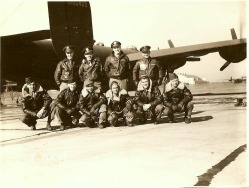
Standing L-R: Francis Pouls, Thomas G. Page, Stephen G. Coffey, Bernard J. Breiter
Crouching L-R: Alex C. Shinsky, Harold Kilpatrick, Unidentified, Lloyd J. Rainbolt (new Engineer), William B. Gannon, Richard W. Martin
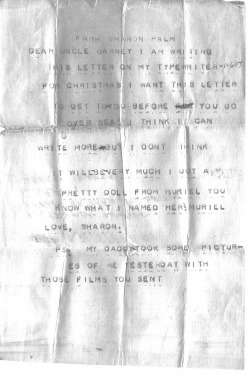
During this time, Barney exchanged Christmas sentiments with his niece, Sharon Palm.
Sharon was overcoming the devastating effects of Polio.
She had received a simple typewriter for Christmas. Sharon also received a doll from Tommy Page and his girlfriend Muriel, sent through Barney. Sharon named the doll Muriel and believed it was a great likeness of her.
Barney and his crew would be headed overseas shortly.
Here is her letter and his reply:
Sharon was overcoming the devastating effects of Polio.
She had received a simple typewriter for Christmas. Sharon also received a doll from Tommy Page and his girlfriend Muriel, sent through Barney. Sharon named the doll Muriel and believed it was a great likeness of her.
Barney and his crew would be headed overseas shortly.
Here is her letter and his reply:
